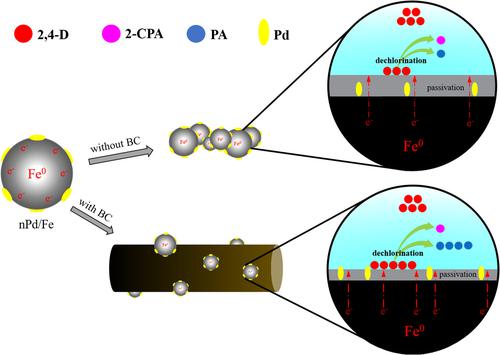当前位置:
X-MOL 学术
›
Appl. Organomet. Chem.
›
论文详情
Our official English website, www.x-mol.net, welcomes your feedback! (Note: you will need to create a separate account there.)
Dechlorination of 2,4‐dichlorophenoxyacetic acid using biochar‐supported nano‐palladium/iron: Preparation, characterization, and influencing factors
Applied Organometallic Chemistry ( IF 3.9 ) Pub Date : 2020-09-21 , DOI: 10.1002/aoc.6010 Hongyi Zhou 1 , Ning Huang 1 , Yongkang Zhao 1 , Shams Ali Baig 2 , Junchao Xiang 1
Applied Organometallic Chemistry ( IF 3.9 ) Pub Date : 2020-09-21 , DOI: 10.1002/aoc.6010 Hongyi Zhou 1 , Ning Huang 1 , Yongkang Zhao 1 , Shams Ali Baig 2 , Junchao Xiang 1
Affiliation

|
In the present study, peanut shell, a green waste raw material, was used to prepare biochar (BC) and to obtain BC‐supported nano‐palladium/iron (BC‐nPd/Fe) composites for removing 2,4‐dichlorophenoxyacetic acid (2,4‐D) from water. Characterization analysis demonstrated that nPd/Fe particles were well dispersed on the BC surface with weakened magnetic properties. The average particle diameter and specific surface area of nPd/Fe were 101.3 nm and 6.7 m2 g−1, whereas the corresponding values of the BC‐nPd/Fe materials were 88.8 nm and 14.8 m2 g−1, respectively. Several factors were found to influence the dechlorination of 2,4‐D, including the weight ratio of BC to Fe, Pd loading ratio, initial solution pH, 2,4‐D concentration, and reaction temperature. Dechlorination results indicated that the 2,4‐D removal and phenoxyacetic acid (PA) generation rates were 44.1% and 20.1%, respectively, in the nPd/Fe system, and 100.0% and 92.1%, respectively, in the BC‐nPd/Fe system. The dechlorination of 2,4‐D was well described by the pseudo‐first‐order kinetic model (R2 > 0.97), and the observed rate constants kobs were 0.0042 min (nPd/Fe) and 0.0578 min (BC‐nPd/Fe), respectively. The reaction mechanism indicated that the dechlorination hydrogenation was the main process to remove 2,4‐D from water in the BC‐nPd/Fe system. In addition, BC inhibited the formation of a passivation layer on the particle surface during the reaction, thus maintaining the high reactivity of BC‐nPd/Fe. The easy preparation technique, high 2,4‐D dechlorination capacity, and mild reaction conditions suggest that BC‐nPd/Fe may be a promising alternative composite to remove 2,4‐D from water.
中文翻译:

使用生物炭负载的纳米钯/铁对2,4-二氯苯氧基乙酸进行脱氯:制备,表征和影响因素
在本研究中,使用花生壳(一种绿色废物原料)制备生物炭(BC),并获得了BC负载的纳米钯/铁(BC-nPd / Fe)复合材料,以去除2,4-二氯苯氧基乙酸( 2,4‐D)从水中。表征分析表明,nPd / Fe颗粒很好地分散在BC表面上,磁性能减弱。nPd / Fe的平均粒径和比表面积分别为101.3 nm和6.7 m 2 g -1,而BC‐nPd / Fe材料的相应值为88.8 nm和14.8 m 2 g -1, 分别。已发现影响2,4-D脱氯的几个因素,包括BC与Fe的重量比,Pd负载比,初始溶液pH,2,4-D浓度和反应温度。脱氯结果表明,在nPd / Fe系统中2,4-D去除率和苯氧乙酸(PA)生成率分别为44.1%和20.1%,在BC-nPd /中分别为100.0%和92.1%。铁系。伪一阶动力学模型很好地描述了2,4‐D的脱氯作用(R 2 > 0.97),并且观察到的速率常数k obs分别为0.0042分钟(nPd / Fe)和0.0578分钟(BC-nPd / Fe)。反应机理表明,在BC-nPd / Fe系统中,脱氯加氢是从水中去除2,4-D的主要过程。此外,BC抑制了反应过程中颗粒表面钝化层的形成,从而保持了BC-nPd / Fe的高反应活性。易于制备的技术,较高的2,4-D脱氯能力和温和的反应条件表明,BC-nPd / Fe可能是一种有望从水中去除2,4-D的复合材料。
更新日期:2020-11-06
中文翻译:

使用生物炭负载的纳米钯/铁对2,4-二氯苯氧基乙酸进行脱氯:制备,表征和影响因素
在本研究中,使用花生壳(一种绿色废物原料)制备生物炭(BC),并获得了BC负载的纳米钯/铁(BC-nPd / Fe)复合材料,以去除2,4-二氯苯氧基乙酸( 2,4‐D)从水中。表征分析表明,nPd / Fe颗粒很好地分散在BC表面上,磁性能减弱。nPd / Fe的平均粒径和比表面积分别为101.3 nm和6.7 m 2 g -1,而BC‐nPd / Fe材料的相应值为88.8 nm和14.8 m 2 g -1, 分别。已发现影响2,4-D脱氯的几个因素,包括BC与Fe的重量比,Pd负载比,初始溶液pH,2,4-D浓度和反应温度。脱氯结果表明,在nPd / Fe系统中2,4-D去除率和苯氧乙酸(PA)生成率分别为44.1%和20.1%,在BC-nPd /中分别为100.0%和92.1%。铁系。伪一阶动力学模型很好地描述了2,4‐D的脱氯作用(R 2 > 0.97),并且观察到的速率常数k obs分别为0.0042分钟(nPd / Fe)和0.0578分钟(BC-nPd / Fe)。反应机理表明,在BC-nPd / Fe系统中,脱氯加氢是从水中去除2,4-D的主要过程。此外,BC抑制了反应过程中颗粒表面钝化层的形成,从而保持了BC-nPd / Fe的高反应活性。易于制备的技术,较高的2,4-D脱氯能力和温和的反应条件表明,BC-nPd / Fe可能是一种有望从水中去除2,4-D的复合材料。


























 京公网安备 11010802027423号
京公网安备 11010802027423号